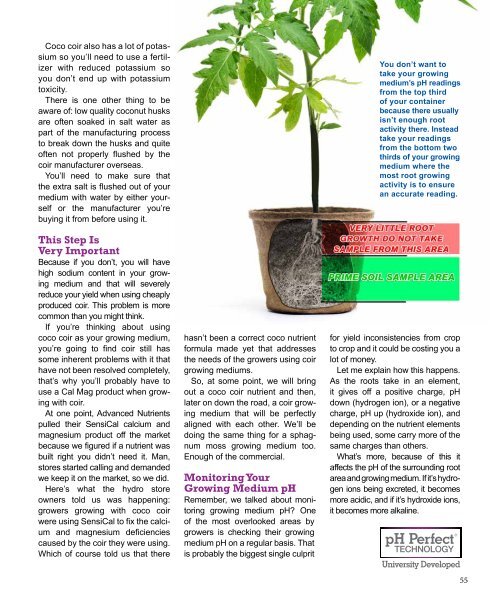You also want an ePaper? Increase the reach of your titles
YUMPU automatically turns print PDFs into web optimized ePapers that Google loves.
Coco coir also has a lot of potassium<br />
so you’ll need to use a fertilizer<br />
with reduced potassium so<br />
you don’t end up with potassium<br />
toxicity.<br />
There is one other thing to be<br />
aware of: low quality coconut husks<br />
are often soaked in salt water as<br />
part of the manufacturing process<br />
to break down the husks and quite<br />
often not properly flushed by the<br />
coir manufacturer overseas.<br />
You’ll need to make sure that<br />
the extra salt is flushed out of your<br />
medium with water by either yourself<br />
or the manufacturer you’re<br />
buying it from before using it.<br />
This Step Is<br />
Very Important<br />
Because if you don’t, you will have<br />
high sodium content in your growing<br />
medium and that will severely<br />
reduce your yield when using cheaply<br />
produced coir. This problem is more<br />
common than you might think.<br />
If you’re thinking about using<br />
coco coir as your growing medium,<br />
you’re going to find coir still has<br />
some inherent problems with it that<br />
have not been resolved completely,<br />
that’s why you’ll probably have to<br />
use a Cal Mag product when growing<br />
with coir.<br />
At one point, Advanced Nutrients<br />
pulled their SensiCal calcium and<br />
magnesium product off the market<br />
because we figured if a nutrient was<br />
built right you didn’t need it. Man,<br />
stores started calling and demanded<br />
we keep it on the market, so we did.<br />
Here’s what the hydro store<br />
owners told us was happening:<br />
growers growing with coco coir<br />
were using SensiCal to fix the calcium<br />
and magnesium deficiencies<br />
caused by the coir they were using.<br />
Which of course told us that there<br />
hasn’t been a correct coco nutrient<br />
formula made yet that addresses<br />
the needs of the growers using coir<br />
growing mediums.<br />
So, at some point, we will bring<br />
out a coco coir nutrient and then,<br />
later on down the road, a coir growing<br />
medium that will be perfectly<br />
aligned with each other. We’ll be<br />
doing the same thing for a sphagnum<br />
moss growing medium too.<br />
Enough of the commercial.<br />
Monitoring Your<br />
Growing Medium pH<br />
Remember, we talked about monitoring<br />
growing medium pH? One<br />
of the most overlooked areas by<br />
growers is checking their growing<br />
medium pH on a regular basis. That<br />
is probably the biggest single culprit<br />
You don’t want to<br />
take your growing<br />
medium’s pH readings<br />
from the top third<br />
of your container<br />
because there usually<br />
isn’t enough root<br />
activity there. Instead<br />
take your readings<br />
from the bottom two<br />
thirds of your growing<br />
medium where the<br />
most root growing<br />
activity is to ensure<br />
an accurate reading.<br />
for yield inconsistencies from crop<br />
to crop and it could be costing you a<br />
lot of money.<br />
Let me explain how this happens.<br />
As the roots take in an element,<br />
it gives off a positive charge, pH<br />
down (hydrogen ion), or a negative<br />
charge, pH up (hydroxide ion), and<br />
depending on the nutrient elements<br />
being used, some carry more of the<br />
same charges than others.<br />
What’s more, because of this it<br />
affects the pH of the surrounding root<br />
area and growing medium. If it’s hydrogen<br />
ions being excreted, it becomes<br />
more acidic, and if it’s hydroxide ions,<br />
it becomes more alkaline.<br />
55


